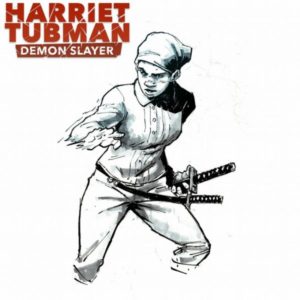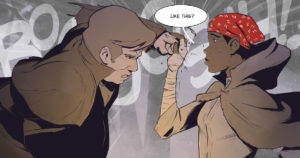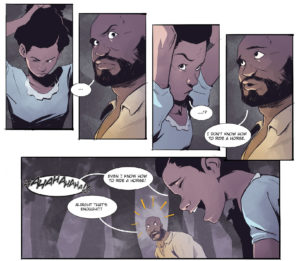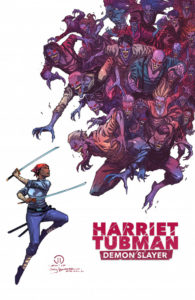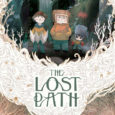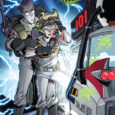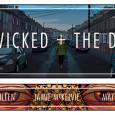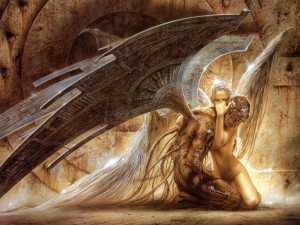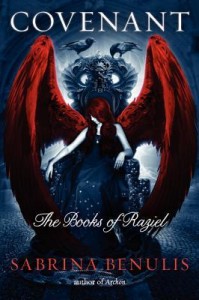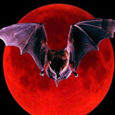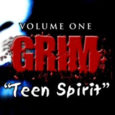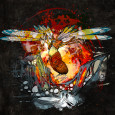For a few years back in the early 2010s horror mash up stories were all the rage. Take an innocuous but well known thing and mix it with a fantasy horror trope and a new hit was made. These were most evident through books like Pride and Prejudice and Zombies and Abraham Lincoln: Vampire Hunter and probably a few others not written by Seth Grahame-Smith. Though that genre has been dormant for a few years, it’s come back quite well with the recent release of Harriet Tubman: Demon Slayer.
Written by David Crownson, Harriet Tubman: Demon Slayer takes place (appropriately) in 1860, deep in the heart of America’s days of Slavery. It opens with a slave family, the Edgefields, as they escape their plantation in search of a life as free folk. When they run afoul of a trio of shady white men, the Edgefields stand their ground only to discover that these men aren’t exactly what they seem to be. Luckily, a mysterious stranger, the eponymous Harriet Tubman, shows up to save them.
One of the things I liked most about the book is the humor. Within the first couple of pages, Crownson makes a joke at the expense of one of his characters and it’s brilliant because it serves a higher purpose than a mere moment of levity. In addition to setting the tone for the book, that initial joke lets the audience know that despite the heady subject matter, they’re allowed to laugh at the story. This is a necessary cue for readers like me, a middle class white man, during the times that the N-word gets bandied around. That word would (rightfully so) make modern audiences uncomfortable but was necessary to tell a story that borrowed heavily from the time of slavery and Harriet Tubman’s real-life struggle. Crownson breaks the ice early to alleviate any possible squeamishness.
The art on the book is superb. Courtland Ellis’ art is smooth, his figures realistic and graceful. There are no overly muscular men rippling through torn shirts. His women aren’t bodaciously disproportioned, and in fact have noticeably different body types. Ellis uses subtle facial expressions on his characters to portray emotions and tip the readers off to what they’re thinking, but he’s then able to go all out during the funny moments. It can be a jarring juxtaposition at times but really ramps up the humor.
The art isn’t perfect, though. Most of the pages are beautiful, however, there’s some panel progression that feels off. Some of the character movement is choppy and stilted, which is detrimental in a book that relies heavily on fight scenes. Thankfully, it’s easy to overlook because there are so many other things to enjoy but hopefully it improves as the series progresses.
Ellis also shines in how he draws backgrounds, notably in the way he uses large brushstrokes to signify foliage. It’s drastically different from mainstream comics and I absolutely love it.
My biggest problem with the book is the dialogue. While most of the characters’ speech is smooth and energetic, the story is sprinkled with one-liners that just seem trite and unnecessary. It tended to be more good than bad, though.
I also wasn’t a fan of the localized dialect. This was probably included to show how different groups speak differently and was effective in establishing the world the story takes place in. I felt like it slowed down the reading experience, forcing me to puzzle out what the characters were saying. I understand that I’m splitting hairs here and maybe sound a little pedantic but this was definitely my take away from the reading experience.
Also, I need to point out the book’s poor punctuation. Normally I don’t even notice the lettering in comic books but the fact that this drew my attention means that it really stood out. Granted, some of the punctuation choices may have been stylistic but there are some instances that are just inconsistent, making the lettering come off as lazy or rushed. Again, I have hope that this will be remedied in future issues.
Despite its flaws, though, one thing that Crownson gets right is the mystery surrounding Harriet Tubman: Demon Slayer. His opening chapter focuses on establishing the characters. He doesn’t dive too far into why the vampires are chasing runaway slaves or even where Harriet comes from. We know nothing of her past, her upbringing, or how she knows how to fight. Crownson reveals just enough to whet my appetite but not too much that I lose interest and don’t return for the second issue.
Having purchased Harriet Tubman: Demon Slayer on a whim during Free Comic Book Day (it was funded through a successful Kickstarter), I have no idea how to get a physical copy of the book. However, you can buy it in digital on Comixology and Peep Game Comix. And I wholly recommend you pick it up. Not only is this book a fun read but it’s also an interesting take on the horror mash-up genre and the life of one of the most prolific American humanitarians.
Grade: B-
*Disclaimer – The copy of Covenant that I am reviewing is an ARC that was received with the intention of a fair review.
*Disclaimer part 2 – As far as I know, God is not dead, seriously though lots of Angels, Demons, and Jinn died during the writing of this review. Angels are fucking crazy man…for reals. I don’t know what you’ve heard about demons and Jinn but those freaks are just as nuts. Really, everyone is fucking insane, really seems to enjoy art and violence. It’s all very odd.
Okay, that got out of hand quickly. I apologize you had to see that Reading Audience, I never wanted to expose you to the gross, inner workings of my diseased mind but it seems like this is one of those times the editors deem it necessary. If you don’t want to find out how deep this rabbit hole goes I suggest turning back now, that unfiltered part comes quickly….heh, “comes quickly”.
I feel like with any good pseudo-religious/YA Fantasy book review we should start out with the requisite blasphemy, and heresy, life wouldn’t be any fun without it. So let’s get to it. I have a confession, I sat at my keyboard for a good 3 hours after finishing Covenant. It’s not easy for me to admit, but I may have tried to masturbate to an airsoft gun enthusiasts magazine. To feel like a man again, that’s how it works right? No?…Well…shit.. Okay…Moving on.
Covenant is the second book in the series The Books of Raziel, it picks up immediately after the events of book one; Archon. Let’s dive right into this, if you liked Archon you are going to enjoy and possibly even love Covenant, if you didn’t enjoy Archon and it’s dearth of sentences describing architecture, environment, and the color of everyone’s hair then Covenant isn’t going to do it for you either. But does that mean I think it is a bad book? Not at all, there are masses of people that fiction like this appeals to. The author, Sabrina Benulis perhaps correctly recognizes this and strives to reach that sort of reader.
For those of you interested in checking out the series, let’s take a quick trip back to Archon to look at what leads into Covenant. The Books of Raziel tell the tale of Angela Mathers (That name bothers me to no end for some reason, still haven’t figured it out.), Angela is what is known in this alternate earth as a Bloodhead which is basically just a redheaded girl or boy. Apparently in this setting being a redhead is comparable to being left-handed in the not too distant past. The difference being redheads are feared because of a prophecy that implies a ginger will destroy the world. This prophecy has lead the Vatican, which seems to be all powerful and more than a little corrupt to found a city to watch over the blood heads and other people with “gifts”.
Welcome to the city of Luz, which is possibly the strongest character in both of the books so far. Ms. Benulis paints a haunting picture of this city mired in superstition and centuries past because of the effects of magic on technology. Luz is what kept me coming back to finish both these books. Which is unfortunate, because in the grand scheme of things when the setting outshines every one of the characters you create to populate it I believe it is time to revisit your notes. For every major player and character Angela meets, I can hardly remember any memorable moments or sympathetic qualities, and while Archon showed some hints at the possibility of future character development Covenant failed to deliver in any sense of the word. Gone is even the pretense, as Covenant seems to careen from violent act to violent act. While things definitely change and shift for the players in the story it seems like all of the changes are cosmetic and don’t actually make the reader care about the characters in any way. Which is disappointing, given that Archon hinted at something better. Maybe the third book in the series can redeem it for me, but at this point much like Angela, I have given in to despair. The book is filled with what for me seemed like trope after trope of mary sues, many of them never even realizing their full potential.
But all cannot be lost, right? For those of you that like stories of Angels, Demons, Jinn, and more supernatural romance than you can shake a stick at, you might enjoy this tale that Sabrina Benulis is crafting. There are hints in both Covenant and Archon of a story that is sitting right at the edges of this one, hoping to be crafted and told in a more fleshed out fashion. Let’s hope that it can find it’s way into the light.
Samuel Smith
Staff Writer
@Samwasbornanerd


